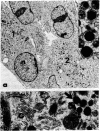Abstract
Diethylnitrosamine is known to cause squamous cell carcinoma and adenocarcinoma of the lung in Syrian golden hamsters. Sections of lungs obtained from hamsters treated with the systemic carcinogen diethylnitrosamine showed a significant increase in the number of argyrophilic cells of neuroepithelial bodies. The hyperplastic response was retained at least 4 weeks after cessation of treatment. To examine whether these affected cells exhibited enhanced survival in vitro, lung cells were dissociated with Pronase and grown in culture. After 7 days, argyrophilia, dense-cored vesicles, and corticotropin-like immunoreactivity were observed in many of the cells derived from hamsters treated for 5 or 8 weeks. These findings suggest that the endocrine-like cells of neuroepithelial bodies are affected by diethylnitrosamine as evidenced by a numerical increase in vivo and by the properties exhibited by cells in vitro. The relationship of this diethylnitrosamine-induced reaction to bronchial carcinoid tumors or small-cell carcinoma of the lung remains to be established.
Full text
PDF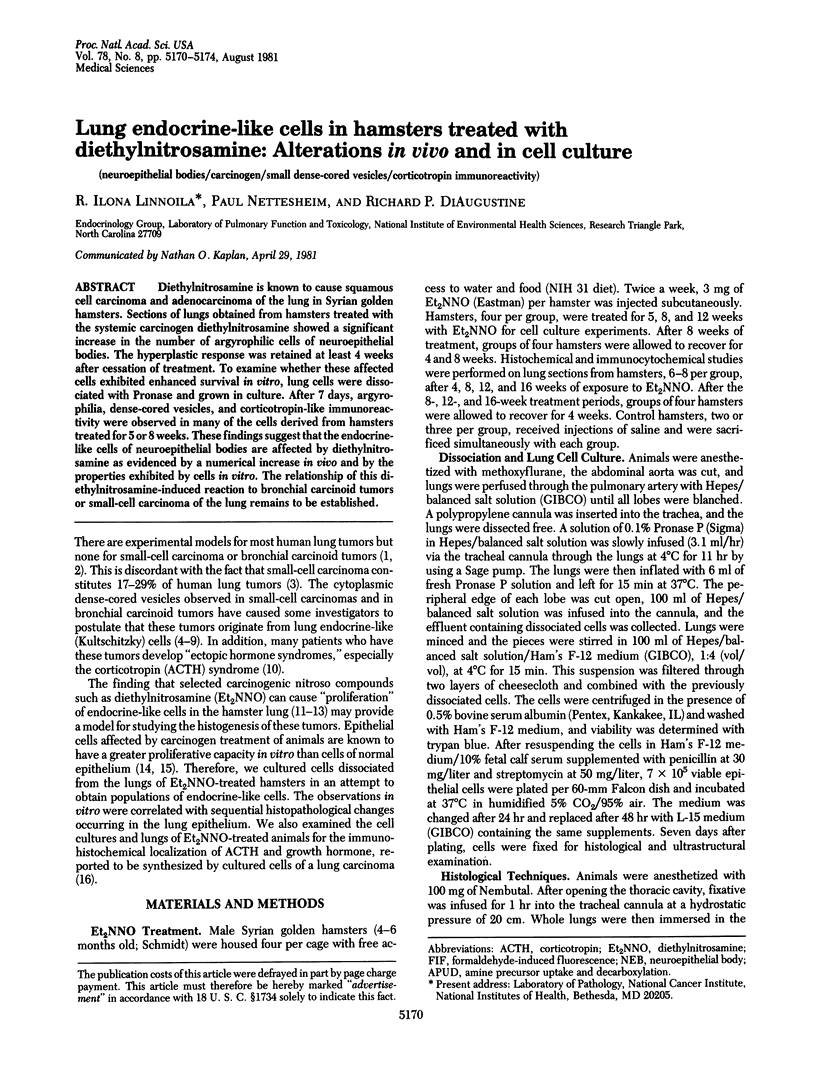
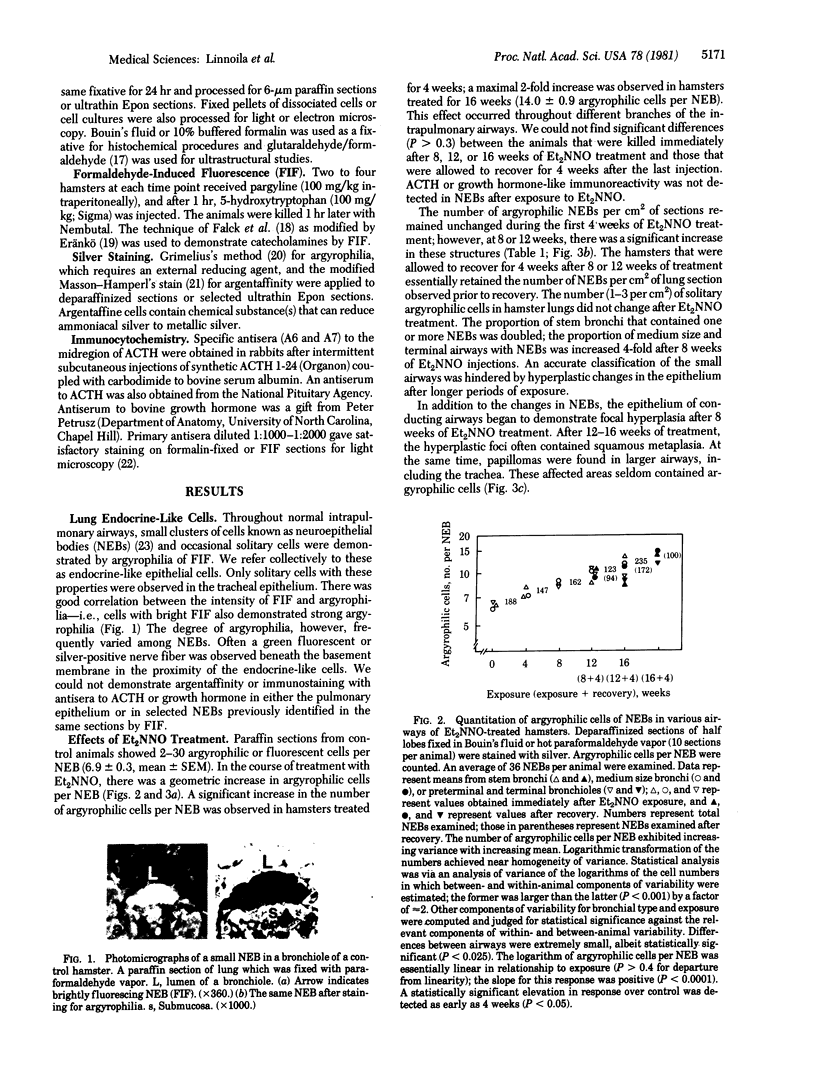
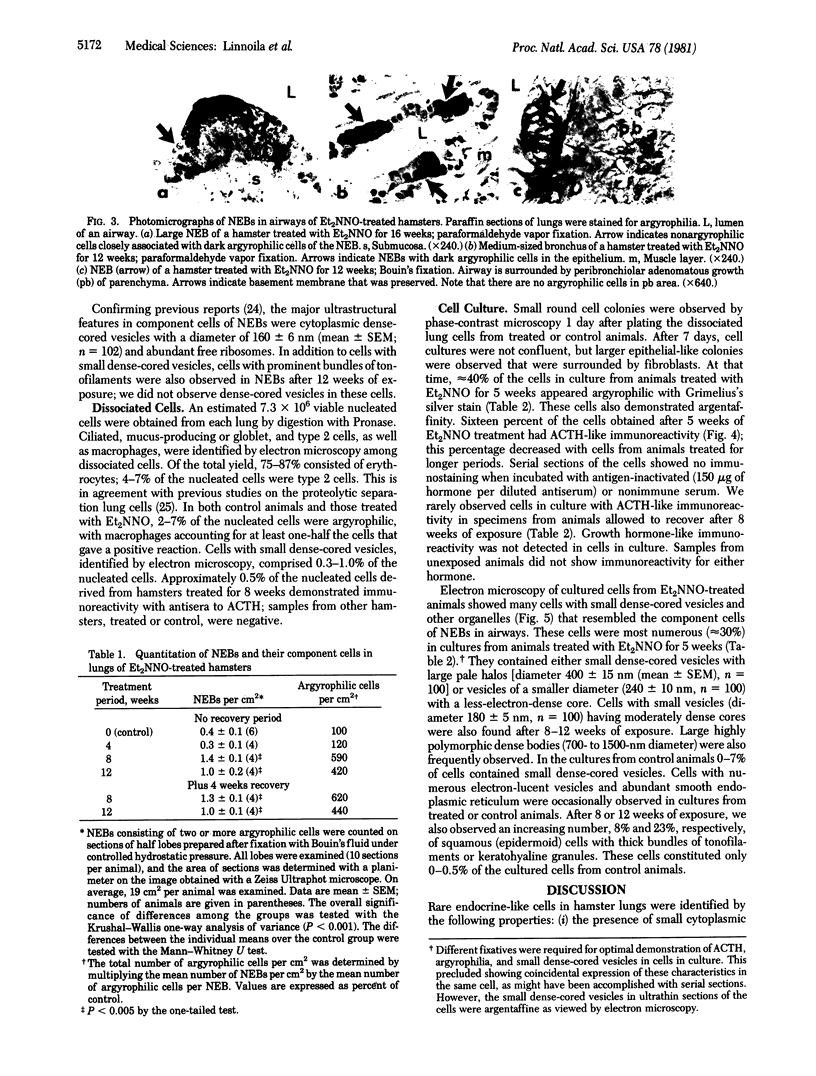
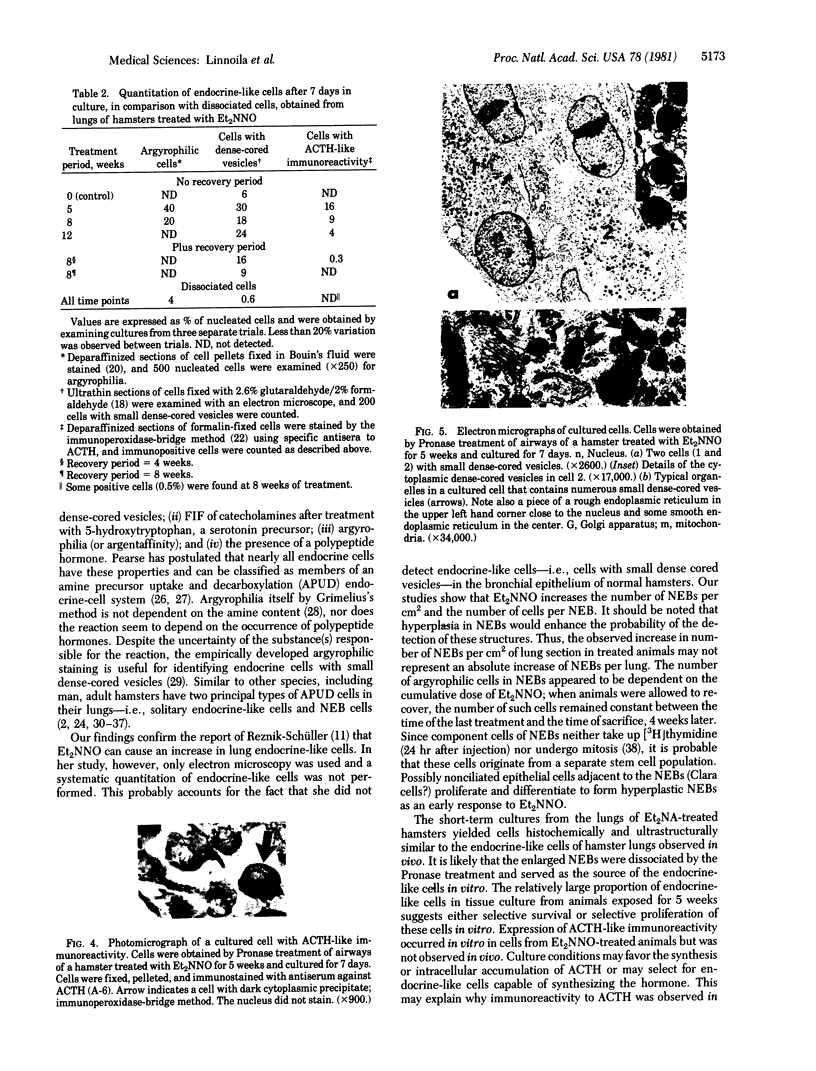
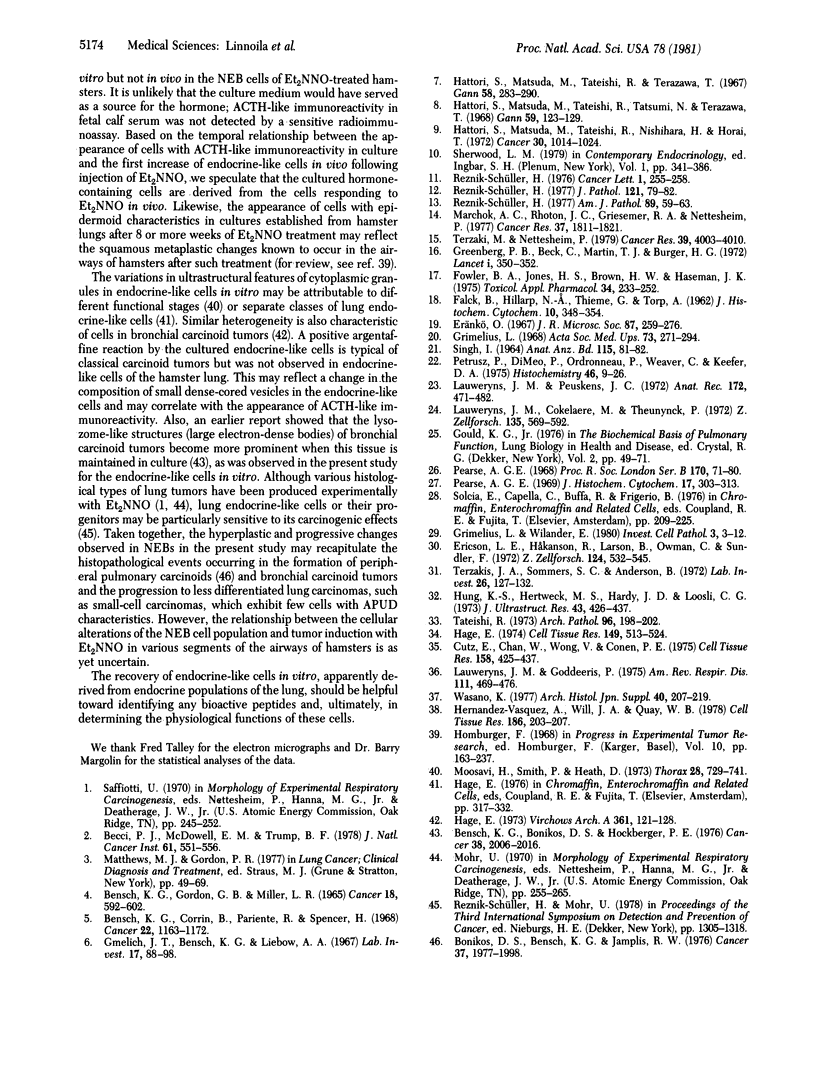
Images in this article
Selected References
These references are in PubMed. This may not be the complete list of references from this article.
- BENSCH K. G., GORDON G. B., MILLER L. R. ELECTRON MICROSCOPIC AND BIOCHEMICAL STUDIES ON THE BRONCHIAL CARCINOID TUMOR. Cancer. 1965 May;18:592–602. doi: 10.1002/1097-0142(196505)18:5<592::aid-cncr2820180508>3.0.co;2-6. [DOI] [PubMed] [Google Scholar]
- Becci P. J., McDowell E. M., Trump B. F. The respiratory epithelium. II. Hamster trachea, bronchus, and bronchioles. J Natl Cancer Inst. 1978 Aug;61(2):551–561. [PubMed] [Google Scholar]
- Bensch K. G., Bonikos D. S., Hockberger P. E. Pulmonary carcinoid tumors is tissue and organ culture. Cancer. 1976 Nov;38(5):2006–2016. doi: 10.1002/1097-0142(197611)38:5<2006::aid-cncr2820380524>3.0.co;2-v. [DOI] [PubMed] [Google Scholar]
- Bensch K. G., Corrin B., Pariente R., Spencer H. Oat-cell carcinoma of the lung. Its origin and relationship to bronchial carcinoid. Cancer. 1968 Dec;22(6):1163–1172. doi: 10.1002/1097-0142(196811)22:6<1163::aid-cncr2820220612>3.0.co;2-l. [DOI] [PubMed] [Google Scholar]
- Bonikos D. S., Bensch K. G., Jamplis R. W. Peripheral pulmonary carcinoid tumors. Cancer. 1976 Apr;37(4):1977–1998. doi: 10.1002/1097-0142(197604)37:4<1977::aid-cncr2820370450>3.0.co;2-4. [DOI] [PubMed] [Google Scholar]
- Cutz E., Chan W., Wong V., Conen P. E. Ultrastructure and fluorescence histochemistry of endocrine (APUD-type) cells in tracheal mucosa of human and various animal species. Cell Tissue Res. 1975 May 20;158(4):425–437. doi: 10.1007/BF00220210. [DOI] [PubMed] [Google Scholar]
- Ericson L. E., Håkanson R., Larson B., Owman C., Sundler F. Fluorescence and electron microscopy of amine-storing enterochromaffin-like cells in tracheal epithelium of mouse. Z Zellforsch Mikrosk Anat. 1972;124(4):532–545. doi: 10.1007/BF00335256. [DOI] [PubMed] [Google Scholar]
- Fowler B. A., Jones H. S., Brown H. W., Haseman J. K. The morphological effects of chronic cadmium administration on the renal vasculature of rats given low and normal calcium diets. Toxicol Appl Pharmacol. 1975 Nov;34(2):233–252. doi: 10.1016/0041-008x(75)90028-9. [DOI] [PubMed] [Google Scholar]
- Gmelich J. T., Bensch K. G., Liebow A. A. Cells of Kultschitzky type in bronchioles and their relation to the origin of peripheral carcinoid tumor. Lab Invest. 1967 Jul;17(1):88–98. [PubMed] [Google Scholar]
- Greenberg P. B., Martin T. J., Beck C., Burger H. G. Synthesis and release of human growth hormone from lung carcinoma in cell culture. Lancet. 1972 Feb 12;1(7746):350–352. doi: 10.1016/s0140-6736(72)92843-7. [DOI] [PubMed] [Google Scholar]
- Grimelius L. The argyrophil reaction in islet cells of adult human pancreas studies with a new silver nitrate procedure. Acta Soc Med Ups. 1968;73(5-6):271–294. [PubMed] [Google Scholar]
- Grimelius L., Wilander E. Silver stains in the study of endocrine cells of the gut and pancreas. Invest Cell Pathol. 1980 Jan-Mar;3(1):3–12. [PubMed] [Google Scholar]
- Hage E. Histochemistry and fine structure of bronchial carcinoid tumours. Virchows Arch A Pathol Pathol Anat. 1973 Nov 12;361(2):121–128. doi: 10.1007/BF00557841. [DOI] [PubMed] [Google Scholar]
- Hage E. Histochemistry and fine structure of endocrine cells in foetal lungs of the rabbit, mouse and guinea-pig. Cell Tissue Res. 1974 Jun 24;149(4):513–524. doi: 10.1007/BF00223029. [DOI] [PubMed] [Google Scholar]
- Hattori S., Matsuda M., Tateishi R., Nishihara H., Horai T. Oat-cell carcinoma of the lung. Clinical and morphological studies in relation to its histogenesis. Cancer. 1972 Oct;30(4):1014–1024. doi: 10.1002/1097-0142(197210)30:4<1014::aid-cncr2820300424>3.0.co;2-e. [DOI] [PubMed] [Google Scholar]
- Hattori S., Matsuda M., Tateishi R., Tatsumi N., Terazawa T. Oat-cell carcinoma of the lung containing serotonin granules. Gan. 1968 Apr;59(2):123–129. [PubMed] [Google Scholar]
- Hattori S., Matsuda M., Tateishi R., Terazawa T. Electron microscopic studies on human lung cancer cells. Gan. 1967 Jun;58(3):283–290. [PubMed] [Google Scholar]
- Hernandez-Vasquez A., Will J. A., Quay W. B. A radioautographic study of the neuroepithelial bodies of the lungs in fetal and neonatal rabbits. Cell Tissue Res. 1978 Jan 17;186(2):203–207. doi: 10.1007/BF00225531. [DOI] [PubMed] [Google Scholar]
- Hung K. S., Hertweck M. S., Hardy J. D., Loosli C. G. Ultrastructure of nerves and associated cells in bronchiolar epithelium of the mouse lung. J Ultrastruct Res. 1973 Jun;43(5):426–437. doi: 10.1016/s0022-5320(73)90019-1. [DOI] [PubMed] [Google Scholar]
- Lauweryns J. M., Cokelaere M., Theunynck P. Neuro-epithelial bodies in the respiratory mucosa of various mammals. A light optical, histochemical and ultrastructural investigation. Z Zellforsch Mikrosk Anat. 1972;135(4):569–592. doi: 10.1007/BF00583438. [DOI] [PubMed] [Google Scholar]
- Lauweryns J. M., Goddeeris P. Neuroepithelial bodies in the human child and adult lung. Am Rev Respir Dis. 1975 Apr;111(4):469–476. doi: 10.1164/arrd.1975.111.4.469. [DOI] [PubMed] [Google Scholar]
- Lauweryns J. M., Peuskens J. C. Neuro-epithelial bodies (neuroreceptor or secretory organs?) in human infant bronchial and bronchiolar epithelium. Anat Rec. 1972 Mar;172(3):471–481. doi: 10.1002/ar.1091720301. [DOI] [PubMed] [Google Scholar]
- Marchok A. C., Rhoton J. C., Griesemer R. A., Nettesheim P. Increased in vitro growth capacity of tracheal epithelium exposed in vivo to 7, 12-dimethylbenz(a)anthracene. Cancer Res. 1977 Jun;37(6):1811–1821. [PubMed] [Google Scholar]
- Moosavi H., Smith P., Heath D. The Feyrter cell in hypoxia. Thorax. 1973 Nov;28(6):729–741. doi: 10.1136/thx.28.6.729. [DOI] [PMC free article] [PubMed] [Google Scholar]
- Pearse A. G. Common cytochemical and ultrastructural characteristics of cells producing polypeptide hormones (the APUD series) and their relevance to thyroid and ultimobranchial C cells and calcitonin. Proc R Soc Lond B Biol Sci. 1968 May 14;170(1018):71–80. doi: 10.1098/rspb.1968.0025. [DOI] [PubMed] [Google Scholar]
- Pearse A. G. The cytochemistry and ultrastructure of polypeptide hormone-producing cells of the APUD series and the embryologic, physiologic and pathologic implications of the concept. J Histochem Cytochem. 1969 May;17(5):303–313. doi: 10.1177/17.5.303. [DOI] [PubMed] [Google Scholar]
- Reznik-Schüller H. Proliferation of endocrine (APUD-type) cells during early N-diethylnitrosamine-induced lung carcinogenesis in hamsters. Cancer Lett. 1976 May;1(5):255–258. doi: 10.1016/s0304-3835(75)97439-x. [DOI] [PubMed] [Google Scholar]
- Reznik-Schüller H. Sequential morphologic alterations in the bronchial epithelium of Syrian golden hamsters during N-nitrosomorpholine-induced pulmonary tumorigenesis. Am J Pathol. 1977 Oct;89(1):59–66. [PMC free article] [PubMed] [Google Scholar]
- Reznik-Schüller H. Ultrastructural alterations of APUD cells during nitrosamine-induced lung carcinogenesis. J Pathol. 1977 Feb;121(2):79–82. doi: 10.1002/path.1711210203. [DOI] [PubMed] [Google Scholar]
- SINGH I. A MODIFICATION OF THE MASSON-HAMPERL METHOD FOR STAINING OF ARGENTAFFIN CELLS. Anat Anz. 1964 Jul 31;115:81–82. [PubMed] [Google Scholar]
- Tateishi R. Distribution of argyrophil cells in adult human lungs. Arch Pathol. 1973 Sep;96(3):198–202. [PubMed] [Google Scholar]
- Terzaghi M., Nettesheim P. Dynamics of neoplastic development in carcinogen-exposed tracheal mucosa. Cancer Res. 1979 Oct;39(10):4003–4010. [PubMed] [Google Scholar]
- Terzakis J. A., Sommers S. C., Andersson B. Neurosecretory appearing cells of human segmental bronchi. Lab Invest. 1972 Jan;26(1):127–132. [PubMed] [Google Scholar]
- Wasano K. Neuro-epithelial bodies in the lung of the rat and the mouse. Arch Histol Jpn. 1977;40 (Suppl):207–219. doi: 10.1679/aohc1950.40.supplement_207. [DOI] [PubMed] [Google Scholar]






